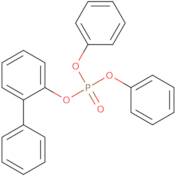2-Biphenylyl diphenyl phosphate
CAS : 132-29-6
Ref. 3D-AAA13229
| 1g | Arrêté | ||
| 5g | Arrêté | ||
| 10g | Arrêté | ||
| 25g | Arrêté | ||
| 500mg | Arrêté |
Informations sur le produit
- 2-Biphenylol, diphenyl phosphate
- 2-Biphenylyl phenyl phosphate ((C<sub>12</sub>H<sub>9</sub>O)(PhO)<sub>2</sub>PO)
- 2-Biphenylyl phenyl phosphate, (C12H9O)(PhO)2PO
- 2-Bisphenyl diphenyl phosphate
- Brn 2174378
- Diphenyl (o-xenyl) phosphate
- Diphenyl mono-o-xenyl phosphate
- Diphenyl o-biphenylyl phosphate
- Dow 5
- Dow plasticizer 5
- Voir d'autres synonymes
- Nsc 2889
- Phosphoric acid, (1,1'-biphenyl)-2-yl diphenyl ester
- Phosphoric acid, 2-biphenylyl diphenyl ester
- o-Phenylphenyl bisphenyl phosphate
- o-Phenylphenyl diphenyl phosphate
- o-Xelenyl diphenyl phosphate
- o-Xenyl diphenyl phosphate
2-Biphenylyl diphenyl phosphate (2BP) is a reducer that can be used to detect the presence of calcium carbonate and fatty acids. 2BP reacts with calcium carbonate, forming biphenyl phosphite and chloride ions in a nonpolar solvent. The reaction can be monitored by measuring the intensity of light emitted at 340 nm. 2BP also reacts with fatty acids, forming an organic product and releasing hydrogen gas. The reaction can be detected by monitoring the release of hydrogen gas with a combustible detector. This reducer is used cosmetically for its ability to activate other functional groups on hair or skin before application of other substances.
2BP is synthesized by reacting biphenyl with phosphorus pentachloride in the presence of a catalyst such as copper(II) chloride, zinc chloride, or manganese dioxide. This process takes about 1 hour and generates a yield of about 50%.





